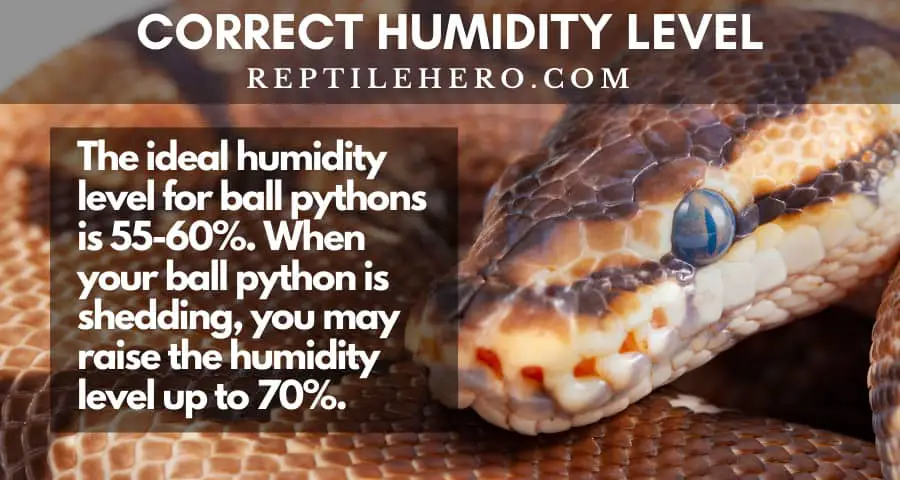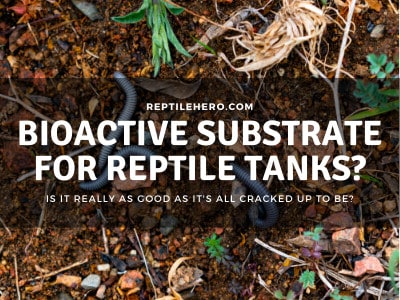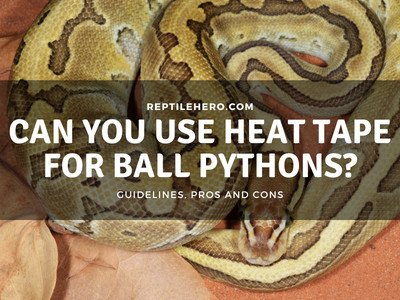Ball Python Dehydration and Wrinkly: Signs and Solutions
Generally, there are 6 signs of dehydration in ball pythons: skin folds and wrinkly, stuck shed, sunken and damaged eyes, food refusal, rapid weight loss, and weakness. Mild cases can be resolved by misting, soaking, hydrating food, and giving electrolyte-infused water. A severely dehydrated ball python should be immediately examined by a veterinarian.
Read on as I discuss signs of dehydration in ball pythons! Find out what you can do about it and how to prevent it from happening again!
How Can You Tell if a Ball Python is Dehydrated? (6 Signs)
The following are the most common signs of dehydration in ball pythons.
Skin Folds Along the Sides of Its Body
Due to lack of water intake, your ball python may have several unusual skin folds in its body. These skin folds will protrude when your snake bends its body and are visible, especially on the neck and the sides.
Stuck Shed
A stuck shed is one of the signs that your ball python isn’t getting enough moisture. Shedding patches on eye caps, body, or the tail are clear indicators that your snake experienced difficulty in shedding.
>> Learn more about shedding in our article on geckos shedding.
Sunken Eyes and Dented Eye Caps
Your ball python’s eyes may slowly start to sink when it is experiencing dehydration, and dented eye caps may occur afterward.
Brille, also known as the ocular scale or spectacle, is a thin and transparent layer covering each ball python’s eye [1]. When your snake is dehydrated, its spectacles may start to fold and eventually split, affecting your pet’s vision.
Food Refusal
Your ball python may refuse its meal due to lack of water. Snakes tend to eat less if they don’t drink enough water [2].
Our ball pythons get their hydration from the food and water we give them. However, ball pythons tend to skip their meals, especially during the shedding cycle. But if you noticed that your ball python is refusing its food together with other signs, then your snake is likely dehydrated.
If your snake is feeding, has successful sheds, and has access to clean water, it should never become dehydrated. Neglect and poor husbandry are the most common causes of dehydration in ball pythons.
Rapid Weight Loss
Your ball python may lose a significant amount of weight in a short period due to insufficient water intake. Ball pythons drink more often than they eat [2]. That being said, water consumption significantly affects your snake’s overall weight.
Weakness
A severely dehydrated ball python may appear weak. Signs of weakness in your ball python may include lethargy, unusual slow movement, and inability to coil when handled.
Rehydrate Your Ball Python
Here’s what I do to help my snake recover from mild dehydration and make those wrinkly disappear.
1. Mist Inside the Enclosure
A great way to rehydrate a ball python and increase the humidity inside its enclosure is through regular misting.
Fill up an empty spray bottle with clean water at room temperature and spray inside the enclosure twice daily.
Misting can also assist your snake in drinking water if it is too weak or does not want to go to its drinking dish. The recommended humidity level inside a ball python’s enclosure is 55-60%.
2. Soak Your Ball Python
Another method to rehydrate a ball python is through soaking. Soaking is also an excellent way to address and resolve cases of stuck shed, mites, and the like in snakes.
When soaking snakes such as ball pythons, the following materials are needed:
- A wide tray to soak your pet’s whole body
- Water with 84-87°F temperature (your snake might suffer from shock if you use colder water, while using warmer water may result in loss of essential oils present in your snake’s scales)
- Clean cloth (for “drying” your snake after soaking)
Here are the simple steps to follow when soaking a ball python:
- Depending on your snake’s size, fill the tray with the water, preferably 1-3 inches deep. It is important to keep the water shallow to prevent your snake from getting tired as the reptile can get tired from swimming in
- Slowly submerge your ball python’s body into the water, starting from the tail up to its neck. You can also try to wet the backside of its body using your hand.
- Continuously soak your ball python for up to 30 minutes. An extended period of soaking may induce stress to your ball python.
- After soaking, lay the clean cloth and place your snake on it to dry out the excess water. Use the fabric and softly press your ball python’s body, leaving enough moisture for the snake to absorb.
When soaking, your ball python may want to get out of the water at first. Use your hand as your snake’s continuous slithering path when it happens.
In doing so, you will be able to soak your ball python’s body easily without the risk of the snake escaping. I always do that when I need to soak my snakes, and it works perfectly.
Soaking a severely dehydrated ball python is not recommended. Visit a vet immediately as your snake badly needs professional medical treatment.
3. Soak Your Snake’s Meal
Before feeding a snake, soak the food first to help the ball python get rehydrated. It gives an extra amount of water that will aid a ball python in its recovery from dehydration.
Submerge the whole feeder in lukewarm water for 1 to 3 seconds before giving it to your snake.
However, please do keep in mind that prolonged soaking could lose the rodent’s scent and can result in your snake being uninterested in the food.
4. Infuse Your Snake’s Drinking Water With Electrolytes
Adding electrolytes to a ball python’s drinking water helps restore the snake’s essential fluids. Keepers and breeders can use electrolyte sources such as Pedialyte, sports drinks (not energy drinks), or electrolyte-infused water.
You can make the electrolyte solution for your snake by mixing 25% of your choice of electrolyte beverage with 75% water.
The goal is to slowly increase fluid levels inside your dehydrated pet. Giving pure electrolyte drink to your dehydrated ball python may cause a sudden increase of unbalanced fluids and minerals that could potentially harm your snake.
You may use an eyedropper or needleless syringe to gently drip the solution into the tip of your ball python’s mouth without forcing the reptile. If your snake seems to be drinking the solution that you made, you may continue offering it this way.
3 Ways to Prevent Ball Python Dehydration
In general, cases of dehydration that also shows with wrinkly skin in ball pythons are mainly caused by poor husbandry. Correct humidity level, availability of drinking water, and proper temperature inside the enclosure should be checked and maintained to avoid this.
1. Correct Humidity Level
Ensure that the humidity inside the ball python’s enclosure is optimal. The recommended humidity level inside the ball python’s enclosure is 55-60%. Low humidity may result in dehydration of the snake. In contrast, higher humidity could cause scale rot, respiratory problems, etc., in ball pythons.
Many individuals, including my friends, struggled to maintain the proper humidity level within their ball python’s enclosure, resulting in health problems—mainly dehydration.
Misting Regularly
Misting twice a day could bump up the humidity inside the enclosure.
If misting manually is too tiring for you, I recommend using a reptile humidifier like this one from Amazon. Using a humidifier for your ball python could save you time and energy.
Partially Covered Top
Another method to maintain humidity inside the enclosure is to cover the top side of your snake’s tank. You may want to cover at least half of the top of the enclosure with aluminum foil to lock in moisture. Adjust the covered area if needed.
Accurate Readings and Monitoring
Of course, you need to measure the humidity level inside your pet’s enclosure. Having a hygrometer like this one from Amazon is highly recommended to accurately monitor the humidity inside the cage.
Boosting Humidity for Shedding
The recommended level of humidity for ball pythons is 55-60%. You can increase the humidity level up to 70% when your ball python is in a shedding cycle.

Humid or Moist Hide
A humidity box is also recommended if you can’t effectively raise the overall humidity level inside the enclosure. Making a humidity box for your ball python is easy, you only need a few things!
Materials needed in creating a humid hide for ball pythons;
- Plastic container with a lockable lid (big enough for your snake to fit inside)
- Paper towels
- Water spray
How to make a humidity box for your snake?
- Create a hole on top of the container’s lid. The hole should be big enough for your snake’s entire body to get through.
- Fill the plastic container with paper towels and spray it with water. Make sure that the whole container does not have excess water.
- Lock the lid with the container and place it inside the enclosure near your ball python.
Tank Substrate
The substrate you use for your ball python also affects the humidity inside its enclosure. It is best not to use aspen shaving for your ball python’s substrate as this cannot hold the moisture that your pet needs.
2. Availability of Drinking Water
A ball python should have access to clean water inside its enclosure. Lack of water may result in snakes suffering from dehydration and other health issues.

I witnessed many ball pythons not having any drinking bowl and water inside their enclosure, which is quite disappointing. When I asked the owners about this, most of them answered that they don’t see their snakes drink, while others said it doesn’t look good to have a water bowl inside the enclosure.
However, we have to remember that in snake-keeping, and pet care in general, we should always prioritize our ball python’s safety and well-being—which in reality includes the availability of drinkable water.
As long as you provide clean drinking water for your snake, there should not be a problem such as dehydration in your snake.
The size of your ball python’s drinking bowl should be wide enough for your snake to soak itself and shallow enough to prevent the animal from drowning. You may want to check this water dish from Amazon.
>> Learn more about drinking water in our article on tap water for ball python.
3. Proper Temperature Inside the Enclosure
The suitable temperature inside the ball python’s enclosure should be monitored as high temperature dries out the cage resulting in dehydration of the snake. The recommended ambient temperatures inside the snake’s enclosure are 75-80°F on the cool side and 80-85°F on the warm side, while the hotspot is 90°F.
Appropriate Lighting
According to recent studies, experts recommend using ultraviolet-B (UVB) lighting in snakes as it can improve their appetite and overall well-being [3].
However, the incorrect bulb type can generate too much heat, which results in stressed and dehydrated snakes. New keepers tend to use inappropriate lighting fixtures for their ball pythons, resulting in dryness inside the snake’s enclosure, including the water bowl itself!
Using a UVB lamp such as this one from Amazon helps promote proper calcium absorption for your snake’s bone health. Vets advise using a UV index meter like this from Amazon to monitor the UV index on the ball python’s basking area. The recommended UV index in a ball python’s basking area is 2 to 3 [4].
Lighting in ball pythons requires a photoperiod to imitate its natural habitat. The cycle of lamps for ball pythons should be 12 hours of daylight and 12 hours of darkness in the winter months. While in the summertime, the recommended period is 14 hours of daylight and 10 hours of darkness [5].
Proper Heating Equipment
You might have heard that ball pythons acquire heat through their belly to digest food, hence the use of under-tank heat mats. However, the use of overhead heating equipment allows for more natural and efficient thermoregulation in ball pythons and reptiles in general.
I highly recommend using a deep heat projector like this from Pangea Reptile for ambient temperature and dimming thermostats. Deep heat projectors are great for creating good basking spots inside the enclosure and use less power consumption than other heating units.
>> Learn more about different heating equipment for reptiles in our article on heating setup for geckos.
Temperature Control Using Thermostats
Another reason why the temperature within your snake’s cage is inaccurate is that heating devices, mainly under-tank heat mats (UTH), are not regulated by thermostats.
Without any regulating device, these heating devices tend to go over the set temperature resulting in the enclosure becoming too hot for your snake.
A thermostat like this from Amazon should always be connected to UTH to avoid overheating the enclosure, which may result in dehydration, burn injuries, or the death of your ball python.
Temperature Monitoring Using Thermometer Guns
A temperature gun, like this one from Amazon, can help you identify the temperature in different spots, especially in the hot zone of your ball python’s enclosure.
Further Questions
How long will it take before a ball python starts getting dehydrated?
A healthy ball python may survive up to 12 days without water but might die of dehydration within a month. Hatchlings, on the other hand, may suffer from dehydration in a shorter period of time.
What are the dangers of dehydration in ball pythons?
Kidney failure, respiratory infections, eye infections, etc., are just some of the dangers to look out for in a dehydrated ball python. Severe cases of dehydration in ball pythons that are left unaddressed can lead to death.
Summary of Ball Python Dehydration
Dehydration in ball pythons is generally caused by poor husbandry. A mildly dehydrated ball python can be easily rehydrated by its keeper. However, a severely dehydrated ball python should be properly and promptly examined by a veterinarian immediately.
A keeper must check and maintain the proper level of humidity, temperature and availability of water inside the snake’s enclosure to prevent different issues such as dehydration.
Sources
[1] https://dbpedia.org/page/Ocular_scales
[2] https://europepmc.org/article/med/28778998
[3] https://pubmed.ncbi.nlm.nih.gov/18241029/
[4] https://www.arcadiareptile.com/lighting/low-uv-species/
[5] https://pendervet.com/2016/10/ball-pythons-what-you-need-to-know/






